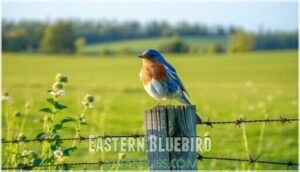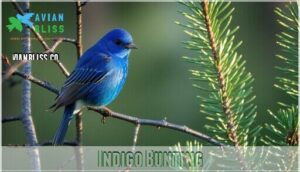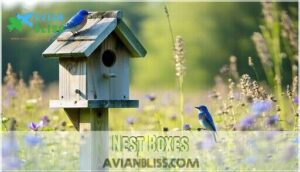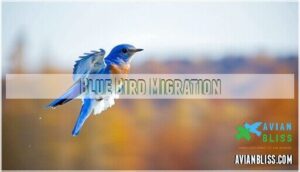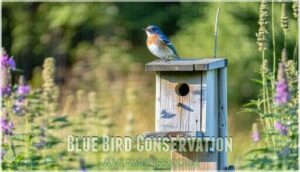This site is supported by our readers. We may earn a commission, at no cost to you, if you purchase through links.
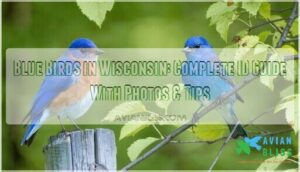
You’ll find Eastern Bluebirds in open grasslands with scattered perches, Indigo Buntings along woodland edges, and Blue Jays practically everywhere from forests to suburban yards.
Mountain Bluebirds occasionally appear during migration, sporting sky-blue plumage without the orange.
These species migrate at different times—some year-round residents, others seasonal visitors, which makes understanding their unique field marks, preferred habitats, and seasonal patterns crucial for identification.
Understanding these patterns makes identification straightforward, even when lighting tricks your eyes into seeing blues where none exist, highlighting the importance of recognizing unique field marks.
Table Of Contents
- Key Takeaways
- Blue Birds Overview
- Blue Bird Species
- Attracting Blue Birds
- Blue Bird Migration
- Blue Bird Conservation
- Frequently Asked Questions (FAQs)
- What kind of blue birds are in Wisconsin?
- How do you attract bluebirds in Wisconsin?
- Do bluebirds stay in Wisconsin year round?
- What color house attracts bluebirds?
- What predators threaten bluebird eggs and nestlings?
- How can bluebird nest box placement maximize success?
- What are signs of successful bluebird nesting?
- How do climate changes impact bluebird migration patterns?
- What are common bluebird territorial behaviors and disputes?
- What time of year do blue birds return to Wisconsin?
- Conclusion
Key Takeaways
- You’ll find three main blue birds year-round or seasonally: Eastern Bluebirds with rusty-orange chests in open grasslands, brilliant all-blue Indigo Buntings along woodland edges, and Blue Jays with distinctive crests in forests and suburbs.
- Attract them with proper nest boxes and food: Install cedar nest boxes 5-6 feet high with 1.5-inch entrance holes for Eastern Bluebirds, offer dried mealworms and suet, and create habitat with native plants that provide berries and insects.
- Migration timing varies by species: Eastern Bluebirds return in March, Indigo Buntings arrive late April through May, while Blue Jays stay year-round, so you’ll need to time your birdwatching accordingly.
- Support conservation through citizen science: Join nest box monitoring programs, report sightings, participate in habitat restoration, and help track population trends to protect these species from threats like habitat loss and climate change.
Blue Birds Overview
Wisconsin’s skies showcase nine distinct blue bird species, from the brilliant cobalt Indigo Bunting to the familiar backyard Blue Jay.
You’ll find these feathered gems in diverse habitats across the state, each with unique identifying features that make spotting them both rewarding and surprisingly straightforward, like the Blue Jay.
Types of Blue Birds
Wisconsin hosts nine distinct blue birds in wisconsin, each showcasing unique plumage variations and size differences.
You’ll spot the brilliant eastern bluebird with its sky-blue back, the all-blue Indigo Bunting (Wisconsin’s only entirely blue species), and the familiar Blue Jay year-round.
Regional subspecies create subtle differences, while aberrant coloration occasionally produces unexpected hues.
Hybridization potential exists between closely related species, making bluebird identification an exciting challenge for wisconsin birds enthusiasts.
Identification Features
Identifying blue birds in Wisconsin starts with observing key features that set each species apart.
Size comparisons help distinguish between the tiny Blue-gray Gnatcatcher and larger Blue Jay.
Plumage variations reveal important clues—males typically display brighter blues than females.
Vocalizations offer another identifying tool, from the Blue Jay’s harsh calls to the Eastern Bluebird’s melodic warbles.
Behavioral traits like feeding patterns complete your identification toolkit for Wisconsin’s blue colored birds, using key features to ensure accurate identification.
Habitat and Distribution
Throughout Wisconsin, blue birds occupy diverse habitats from open prairies to woodland edges.
Climate impacts and habitat fragmentation affect range overlap, forcing niche partitioning among species.
Urban adaptation varies—Blue Jays thrive in cities while Eastern Bluebirds prefer rural areas.
Ideal nesting locations include open woodlands.
Wisconsin wildlife watchers find bird habitats in Wisconsin span agricultural lands to forests, creating prime bird watching locations where species coexist.
Blue Bird Species
Wisconsin hosts several stunning blue bird species that’ll catch your eye throughout the year.
You’ll encounter the vibrant Eastern Bluebird with its sky-blue back and rusty chest, the all-blue Indigo Bunting during summer months, the bold Blue Jay year-round, and occasionally the Mountain Bluebird in open areas.
Eastern Bluebird
Spotting eastern bluebirds in Wisconsin wildlife areas brings joy to any birdwatcher.
Males display brilliant sky-blue plumage variation on their backs and wings, contrasting with rust-orange chests.
Females show more subdued blue-gray tones.
Their diet specifics include insects and berries.
Melodic warbling song characteristics make identification easier.
Thanks to dedicated nest box programs, eastern bluebird population trends show remarkable recovery, with nesting success rates steadily improving across suitable bluebird nesting sites, which are typically open bluebird habitat with scattered perches, preferred by these cavity-nesters.
Indigo Bunting
You’ll recognize the male Indigo Bunting by his brilliant blue plumage that shimmers like a sapphire in sunlight.
A flash of sapphire catches your eye—the Indigo Bunting glows blue against summer leaves.
These sparrow-sized wisconsin bird species arrive mid-April, seeking brushy woodland edges for breeding success.
Males sing complex territorial songs from dawn to dusk, earning them the nickname "blue canaries."
Their diet specifics include seeds and insects, while habitat selection favors dense shrubland mixed with open areas for ideal bird identification during wisconsin bird watching.
Their vibrant blue color is due to light refraction rather than pigment.
Blue Jay
Blue Jays are Wisconsin’s most recognizable year-round residents, sporting vivid blue plumage with distinctive crests and bold personalities.
Nothing brightens a Wisconsin backyard like the flash of a Blue Jay’s vibrant blue wings and lively antics.
These intelligent corvids display remarkable social behavior, often traveling in family groups while demonstrating impressive vocal mimicry abilities.
Their Wisconsin range spans statewide, from urban parks to dense forests.
Jay intelligence shines through problem-solving skills and complex communication, and these common Wisconsin birds exhibit varied feeding habits, consuming everything from acorns to insects.
Making them fascinating subjects for bird watching Wisconsin enthusiasts seeking Wisconsin wildlife encounters, with their ability to thrive in various environments being a key aspect of their social behavior.
Mountain Bluebird
While Blue Jays grab attention with their bold calls, Mountain Bluebirds offer a quieter beauty in Wisconsin’s Open Landscapes.
These all-blue males lack the rusty chest of Eastern Bluebirds, preferring Habitat Preference of meadows and prairies. Their Insect Diet and Cavity Nesting habits make them perfect for Wisconsin blue birds enthusiasts seeking diverse bird identification guide experiences.
They’re known to thrive in high mountain meadows.
Why Mountain Bluebirds captivate Wisconsin birders:
- Males shimmer like living sapphires against green meadows
- Their High-Pitched Songs create peaceful morning soundscapes
- Hovering flight patterns make them mesmerizing to watch
- Cavity Nesting behavior connects you to conservation efforts
- Open Landscapes preference offers easy viewing opportunities
Attracting Blue Birds
You’ll find success attracting Wisconsin’s blue birds by focusing on their specific needs for nesting sites, food, and habitat.
Different species require different approaches, from nest boxes for Eastern Bluebirds to diverse feeding stations for Blue Jays and Indigo Buntings, which can help in attracting these blue birds.
Nest Boxes
Proper nest boxes can make your yard a magnet for Eastern Bluebirds and other blue birds in wisconsin.
Choose bluebird houses with 1.5-inch entrance holes and place them 5-6 feet high in open areas.
Install predator guards on poles to keep snakes and raccoons out.
Use cedar or pine for box materials – they’re naturally weather-resistant.
You can even purchase bluebird houses online for convenience.
Check boxes weekly during breeding season for monitoring boxes success, and clean them annually for proper box maintenance.
Food Sources
Providing the right food transforms your yard into a bluebird buffet. Their insectivorous nature means dried mealworms work best—sprinkle them on platform feeders filled with sand.
During winter, offer suet alternatives like crushed peanuts and hulled sunflower seeds. While bluebirds rarely visit nectar feeders, they’ll gobble up berries from native plants.
Understanding their foraging habits helps you stock the perfect bluebird diet year-round. Creating an insect based food source is essential for attracting bluebirds with insect rich diets.
Habitat Requirements
When you set out to attract blue birds in Wisconsin, think of their favorite real estate: Forest Edges, Grassland Habitats, and WoodlandEdges near open spaces.
Wetland Areas and Rural Landscapes also offer prime bird habitats.
These spots give birds food, shelter, and nesting sites, helping with bird conservation in Wisconsin, one backyard at a time, by mimicking natural Wisconsin wildlife spaces.
Blue Bird Migration
You’ll notice that many blue birds in Wisconsin don’t stick around all year, instead traveling long distances to find the best breeding and wintering spots.
Understanding their migration patterns helps you spot these birds at the right time, so you won’t miss their brief but colorful visits.
Seasonal Patterns
After you’ve set up the perfect spot, timing plays a big role.
Wisconsin’s bluebird migration follows clear seasonal patterns.
Breeding seasons kick off in spring, with nesting cycles peaking as days warm.
Watch for flocking behavior as migratory birds gather before heading south.
These bird migration patterns and wintering patterns shape when you’ll spot bluebirds along their annual journey.
Migration Routes
Ever wonder how bluebird migration works? Migration routes aren’t random—these birds follow specific Flyway Patterns shaped by Route Ecology and Seasonal Movements.
Check out these migration maps and bird tracking facts:
- Indigo Buntings follow central flyways.
- Barn Swallows use broad routes.
- Eastern Bluebirds shift locally.
- Belted Kingfishers follow rivers.
- Migration routes change yearly.
Understanding the best bird migration routes involves studying flyway conservation to protect these species.
Wintering Grounds
As bluebird migration wraps up, you’ll find most blue birds in Wisconsin heading for warmer Southern Habitats.
These wintering grounds stretch from central Mexico to the southern U.S., where Winter Feeding is easier.
Flocking Behavior helps them survive Cold Climates.
Watching bird migration patterns in Wisconsin gives you a front-row seat to the journey bird species in North America take each year, showcasing their Flocking Behavior.
Blue Bird Conservation
When you help protect blue birds in Wisconsin, you’re supporting species that play a key role in local ecosystems.
Conservation means tackling threats like habitat loss and competition, so these bright birds can keep filling your backyard with color.
Threats and Challenges
You’ll notice blue birds in Wisconsin face real bird conservation challenges.
Habitat loss and fragmentation shrink their nesting spots, while climate change messes with migration and breeding.
Pesticide use wipes out essential insects, and window collisions add extra risk.
Human impact, like urban sprawl, increases threats to Eastern Bluebird survival, and bird species conservation demands tackling these ongoing issues head-on, including addressing climate change.
Conservation Efforts
Jump in and help bluebird conservation by supporting bird conservation efforts in Wisconsin.
Here’s how you can make a difference:
- Join Nesting Initiatives—install and maintain nest boxes.
- Support Habitat Restoration—volunteer for prairie or wetland projects.
- Advocate for Species Protection—back Wildlife Preservation and Ecosystem Management groups.
These steps boost blue birds in Wisconsin and strengthen Wisconsin bird conservation.
Supporting regenerative agriculture efforts can also substantially help bird populations, which is crucial for Wildlife Preservation.
Citizen Science and Monitoring
Clipboards and binoculars in hand, you can join volunteer programs across Wisconsin to help with bluebird conservation.
Citizen science lets you report sightings, assist with nest box monitoring, and practice species identification.
Your data collection supports bird population monitoring and helps track eastern bluebird trends. Every checklist you submit adds valuable insight for Wisconsin wildlife and bluebird conservation efforts.
Habitat Protection and Management
When you set out to protect bird habitat, you’re really rolling up your sleeves for all of Wisconsin wildlife.
Focus on these three steps:
- Remove invasive species that crowd out native plants.
- Support habitat restoration and smart land use.
- Watch water quality—clean streams mean healthier bluebird conservation.
Effective habitat management often requires invasive species control.
Every action helps eastern bluebird and bird habitat preservation thrive, even with climate change challenges, and supports habitat restoration.
Frequently Asked Questions (FAQs)
What kind of blue birds are in Wisconsin?
Wisconsin’s skies sparkle with avian jewels! You’ll spot Blue Jays year-round, Eastern Bluebirds during summer, plus Indigo Buntings, Barn Swallows, and Belted Kingfishers gracing your backyard adventures.
How do you attract bluebirds in Wisconsin?
Install nest boxes five to six feet high in open areas with minimal tree cover.
Face openings away from prevailing winds and maintain boxes annually to encourage Eastern Bluebirds to return.
Do bluebirds stay in Wisconsin year round?
Like migrating butterflies following ancient paths, Eastern Bluebirds don’t stick around Wisconsin’s harsh winters.
They’re partial migrants – some head south while others brave nearby milder areas, returning when spring’s warmth beckons them back home to their ancient paths.
What color house attracts bluebirds?
Natural wood tones work best for bluebird houses.
You’ll want unpainted cedar, pine, or fir that weathers to gray.
Avoid bright colors, white, or dark shades that absorb heat and deter these cavity-nesting birds from choosing your box.
What predators threaten bluebird eggs and nestlings?
You’ll face several predators targeting your bluebird eggs and nestlings.
House wrens destroy eggs, while raccoons, snakes, and cats raid nests.
Squirrels and chipmunks also threaten eggs and young birds in nesting boxes.
How can bluebird nest box placement maximize success?
Consider your nest box like a castle protecting royal heirs—position it five feet high, facing east, in open grassland one hundred yards from trees.
You’ll shield eggs from predators while providing safe flight paths for fledglings to thrive.
What are signs of successful bluebird nesting?
You’ll spot successful bluebird nesting through regular egg laying, consistent parent activity, and fledgling sounds.
Watch for parents carrying food frequently, defensive behavior around the box, and eventually young birds leaving the nest, which indicates successful bluebird nesting.
How do climate changes impact bluebird migration patterns?
You’ll notice shifting temperatures alter when bluebirds arrive and depart. Warmer springs prompt earlier migration, while unpredictable weather disrupts their timing, affecting breeding success and food availability along traditional routes.
What are common bluebird territorial behaviors and disputes?
Like neighborhood watchdogs, bluebirds fiercely defend territories through aggressive displays, chasing intruders, and vocal warnings.
You’ll observe males perching prominently, spreading wings, and engaging in aerial chases to protect nesting sites from competitors, and this behavior is a key part of their territorial defense, which includes aggressive displays.
What time of year do blue birds return to Wisconsin?
Most blue birds return to Wisconsin between March and May, depending on the species.
You’ll see Eastern Bluebirds arriving first in March, followed by Indigo Buntings in late April through May.
Conclusion
Coincidentally, just as Wisconsin’s seasons shift from vibrant fall colors to winter’s stark landscape, blue birds in Wisconsin follow their own predictable patterns.
You’ve now learned to distinguish the Eastern Bluebird’s rusty breast from the Indigo Bunting’s brilliant plumage and the Blue Jay’s distinctive crest.
Armed with knowledge of their habitats, migration timing, and field marks, you’re ready to confidently identify these stunning species whether they’re year-round residents or seasonal visitors gracing your backyard.
- https://abcbirds.org/bird/eastern-bluebird/
- https://dnr.wisconsin.gov/sites/default/files/topic/Fishing/Pubs_FishWildlifeHabitatPlan.pdf
- https://birdsoftheworld.org/bow/species/easblu/cur/introduction?printable
- https://wildlife.onlinelibrary.wiley.com/doi/10.1002/jwmg.22568
- https://minds.wisconsin.edu/bitstream/handle/1793/81337/Zolkowski.pdf?sequence=1&isAllowed=y

